Abstract
The main purpose of this study is to evaluate the applicability of a liquid desiccant and evaporative cooling-assisted 100% outdoor air system (LD-IDECOAS) in six typical cities in China. The six cities are located in different climatic zones in China and are selected because they are comparable owing to the outdoor air conditions. Many studies have shown that the annual operating energy consumption of LD-IDECOAS is nearly half compared with the conventional variable air volume (VAV) system. Because the climate characteristics of the six selected cities were different, the appropriate mode of operation of the LD-IDECAOS was applied to each studied city, and energy simulations were performed. Based on the design conditions of each region, the required cooling and heating loads were calculated for office buildings using transient system simulations (TRNSYS) 17, and the performance of the LD-IDECOAS and its energy consumption were simulated with a commercial engineering equation solver (EES) program. Depending on the climate characteristics of each city, adequate modifications were evaluated with simulations in terms of energy consumption. The proposed system was compared with the VAV system and the evaporative cooling assisted 100% outdoor air-conditioning system (IDECOAS) for detailed simulation results in the effort to evaluate the energy-saving potential. Finally, the results show that the proposed system saves considerable energy over conventional VAV systems and, in summer, the applications save even more energy than IDECOAS. However, there is a slight difference between the different geographical regions in terms of the annual operating energy consumption. In summary, the proposed system can yield significant energy-saving benefits in hot and humid regions whereas, in dry regions, the proposed system is more applicable in the summer. Consequently, LD-IDECOAS can be adopted for different climatic zones as a heating, ventilating, and air-conditioning (HVAC) system by introducing 100% outdoor air.
1. Introduction
Recently, indirect and direct evaporative cooler assisted 100% outdoor air systems (IDECOAS) have gained popularity as energy-efficient and environment-friendly air-conditioning systems compared with conventional variable air volume (VAV) systems. This system can reduce the required cooling energy by precooling the supplied air using evaporative cooling. Recent studies have investigated the possibility of significant cooling energy reduction [1,2,3]. Gilani and Poshtiri developed a mathematical model for two-stage evaporative coolers and studied the geometrical and physical properties of the proposed system under various outdoor conditions. It was also concluded that the proposed system could satisfy the thermal comfort conditions under the specified temperature and humidity range [4]. There is also a literature that develops a model that describes the process of heat and mass transfer for a cross-flow configuration indirect evaporative cooling system (IECS). The performance of IECS was shown through simulation results such as air properties and surface wettability [5]. Under a specific temperature range, the counter-flow direct evaporative cooling (DEC) system was used to analyze the heat and mass transfer characteristics through experiments with other variable parameters. The results of driving force of DEC was more sensitive under specific temperature were obtained [6]. Lotfizadeh and Layeghi described a simple yet innovative solar evaporative cooler and conducted tests under different temperature conditions in the room. The performance of the proposed system was evaluated and it was concluded that high performance cooling pads and solar panels could improve performance [7]. Cannistraro et al. [8] proposed a “local mean radiant temperature” and conducted a study on local comfort conditions using the corresponding values obtained from the mean radiant temperature proposed in the literature. They also proposed an action on the domestic climate control in which duct and ventilation air distribution are located in different zones and compared the parameter values by the local radiant temperature proposed in previous studies. Additionally, it was found that the air velocity or temperature should always be changed from the air vent to obtain the most comfortable condition [9].
However, in the case of hot and humid conditions, it is considered that the inflow of outside air has a limitation that can improve the cooling performance only by evaporative cooling. To solve these problems, it is considered that the system can be integrated with the liquid desiccant (LD) system in a hot and humid environment, thereby increasing the cooling efficiency. The reason for the integration of the LD system is that the non-vapor compression-type air-conditioning technology, such as the evaporative cooling system, is ranked high in its energy-saving potential [10]. The system is considered to save energy and be environmentally friendly.
A liquid desiccant and evaporative cooling-assisted 100% outdoor air system (LD-IDECOAS) consists of a liquid desiccant that reduces the energy consumption of the evaporative cooler and is capable of deeper dehumidification. The liquid passes through the LD unit to be dehumidified and reduces the wet bulb temperature (WBT) of the outside air. In this system, the LD unit possesses the most important role: it has a significant effect in increasing the cooling potential of the evaporative cooler and in reducing the total energy consumption. In the summer, the hot and humid outside air passes through the LD unit to dehumidify and lower the WBT of the outside air. In the LD system, a cooling device is installed to cool the desiccant solution in the absorber and there is a heating coil to regenerate the desiccant solution in the regenerator.
Various published studies exist and other research studies are ongoing on the new technology that can sufficiently attain the energy-saving effect in the selection of the cooling and heating device of the LD part. In the current literature, experiments were conducted on a system that consisted of a dehumidifier with a regenerator, cooling tower (CT), plate heat exchanger, and a control device. The CT was used to cool the desiccant solution. Calcium chloride and lithium chloride were used as the desiccant solutions and the performance of the system was evaluated based on the water removal rate, dehumidifier, and regenerator efficiency [11]. A hybrid open-cycle vapor absorption and liquid desiccant system using LiBr solution was also simulated for the absorption and dehumidification process. In the system, a weak solution was regenerated by a partly closed-open solar regenerator and a CT was used on the dehumidifier side. This system has been presented as an excellent alternative, especially in hot and humid climates [12]. Water-side free cooling can be seen as a very promising alternative for the cooling of the strong desiccant solution with cooling water from the CT. A solar-regenerated liquid desiccant ventilation preconditioning system has been simulated with the use of solar energy in the regeneration process and the provision of cooling water to the CT [13]. There is also existing literature on the simulation and preliminary experiments connected to the liquid desiccant system and the solar collector field used to regenerate the desiccant solution and hot water [14]. Therefore, according to the current literature, the solar system has an increased potential if it is used in the regenerator, but now it can be confirmed that district heating is more applicable to the current situation in China. Through related data, China has the second largest district heating capacity in the world, whereby the heating area in China is very large, and the use of district heating tends are expected to increase at a faster rate in the future [15]. There have also been studies comparing the cost of heating and hot water supply provided by district heating to alternative potential systems [16]. Two approaches were evaluated for high-efficiency heat generators or heat pumps and an assessment of the technical and economic feasibility of the payback period was performed. In this study, when simulations were performed, the regeneration side was heated by district heating to regenerate the weak solution. In the LD-IDECOAS, the latent heat load is treated by the LD system. The air is passed through an indirect evaporative cooler (IEC) and a direct evaporative cooler (DEC) to handle a sensible load. LD-IDECOAS, which is drawing attention as a non-vapor compression air-conditioning system, has been simulated to evaluate the effect of the LD system on the evaporative cooler, showing that it consumes 51% less cooling energy than conventional VAV systems [17]. In addition, research on the LD-IDECOAS has shown that it saved 68% of the annual operating energy compared to the VAV system and 23% compared to IDECOAS [18]. There are also studies to analyze the energy performance of LD-IDECOAS using a heat pump compared to the conventional LD-IDECOAS that uses a boiler to regenerate low-concentration solutions. The result shows that the energy is reduced by about 33% compared to the conventional LD-IDECOAS [19]. Park and Jeong [20] also evaluated the energy performance of the LD-IDECOAS marine applications. Unlike the conventional system, seawater is applied as a cooling source in this system and the recovered waste heat is applied as a heating source. In the cooling process under normal climatic conditions, it decreased 57–70%. Under normal climatic conditions, compared to conventional constant air volume (CAV) systems, the energy decreased by 57–70% for cooling and 39% for heating.
China, the country with the third largest land area in the world, has various climatic zones in each of its regions. Owing to this large area of land and complex terrain, the conditions of the outdoor air are different in different regions in the same season. Humidity differences are also considerable. Therefore, the choice of HVAC technology for a specific regional climate is considered a good way to prevent the waste of resources. Duan et al. [21] designed and manufactured counter-flow regenerative evaporative coolers (REC), conducted experiments under various climatic conditions in China and in all of its regions. The results showed that the expected annual energy savings of 53–100% were reduced and that the electrical energy consumption was estimated to be reduced by 13–58%. LD-IDECOAS can be operated according to the seasonal operating mode and system configuration and can be adjusted according to the ambient conditions of each region—that exhibit considerable differences in humidity—thereby benefitting from the energy viewpoint.
In this study, six representative cities were selected, which were located in different climatic zones in China. Under the same model building and the same setting conditions, the annual thermal load variation was calculated and the simulation was performed with the appropriate operation strategy for each region. In the course of the simulation, the conventional VAV system, the IDECOAS, and the LD-IDECOAS, were operated and simulated. The obtained results will be used to analyze and compare the respective energy savings.
2. System Overview
2.1. LD-IDECOAS
LD-IDECOAS uses fresh, 100% outdoor air, without any return air from the room. The air is supplied to the conditioning room through the LD and evaporative cooling sections of the system (Figure 1). In the construction of the proposed system, the outdoor air is first dehumidified by the LD unit. Subsequently, the processed air passes through the installed evaporative cooling unit, IEC, and direct evaporative cooler (DEC) and is subjected to sensible cooling to meet the supply air set point. The LD system consists of a regenerator, a dehumidifier, a sensible heat exchanger (SHE), a heating coil (HC) for heating the weak solution and a cooling coil (CC) for cooling the strong solution. As the processed air passes through the dehumidifying part of the LD, the strong solution that is injected into the dehumidifying part removes the moisture from the air. After the dehumidification process, the weakened solution in the dehumidifier enters the regeneration section and reverts to a strong solution through the water evaporation process. During the evaporation process, the vapor pressure must be high and the weak solution first enters the SHE. It is first heated and then reheated by the HC. The HC and the SHE are located in the exhaust side of the system so that exhaust air can be sent to the secondary channel of the IEC. When the evaporative cooling system provides sensible cooling, on the secondary side of the IEC, the lower side of the WBT is selected from the outside air, and the exhaust air to be sent to the secondary channel and a better cooling effect can be attained by cooling the processed air that passes through the primary side. Depending on the thermal load required for the air-conditioning space, the flow rate of air supplied to the room fluctuates. The advantage is similar to the VAV system. The path highlighted in blue in Figure 1 is the path through which the cooler supplies air to the air-conditioning space. Additionally, the area marked in red indicates the path of the indoor return air and the exhaust air.
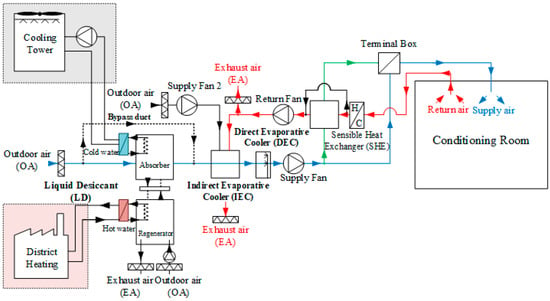
Figure 1.
The schematic of LD-IDECOAS.
The proposed system has four operational modes corresponding to each of the four areas of the psychrometric chart (Figure 2). The operating mode is selected according to the outdoor air conditions of the six regions selected to be studied when the system is in operation. The operation mode of the LD-IDECOAS was also mentioned in the literature [20].
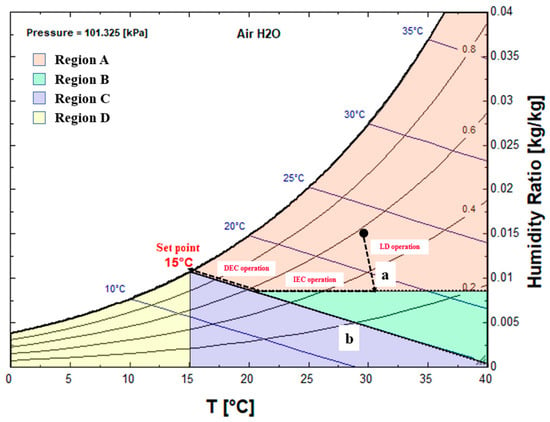
Figure 2.
The operating modes for LD-IDECOAS depicted on a psychrometric chart.
The red part in Figure 2 is the A mode of operation and the outdoor air is hot and humid in the summer. The high temperature and humidity of the outdoor air is dehumidified using the LD unit installed in the proposed system until it reaches the set air supply humidity ratio line indicated by the line denoted by the letter “a”. After the dehumidification process is completed, the air passes through the IEC and DEC, and undergoes an adiabatic cooling process along the isentropic path until the air supply target temperature is reached. The heat of the adiabatically cooled air that passes through the primary channel of the IEC is removed by the water spray of the secondary channel. Finally, the processed air is cooled to a target supply air (SA) state (that is, 15 °C saturated conditions) via the DEC and is provided to the conditioned zone. Additionally, DEC does not always work. If only the LD and IEC operate and the supply air set point can be met, the operation of the DEC is not required. Otherwise, the processed air is cooled adiabatically by the DEC to the target supply air set point.
As shown in the green and purple colors in Figure 3, regions B and C indicate that the ambient conditions are intermediate seasons, the LD unit is deactivated, and the system is operated mainly by sensible cooling through the cold and neutral decks. Regions B and C are distinguished by the line denoted with the letter “b”, and the WBT or the enthalpy of the set point (that is, saturation at 15 °C). The processed air bypasses the LD and is first sensibly cooled through the IEC to drop its temperature to the target temperature or the enthalpy of the SA set point (that is, 42.1 KJ/kg). DEC performs the adiabatic cooling process until the supply air set point is met. Area C corresponds to the condition where the outside air temperature is higher than the SA set point, and at which the enthalpy is lower than the target supply air condition, the LD unit and IEC operation are stopped and turned off and only the operation of DEC is satisfied by the target supply air temperature. Heat recovery through SHE will achieve the air supply set point temperature of the neutral deck. If only SHE is operating, and the set temperature cannot be achieved, additional heating will be performed with the use of the HC.
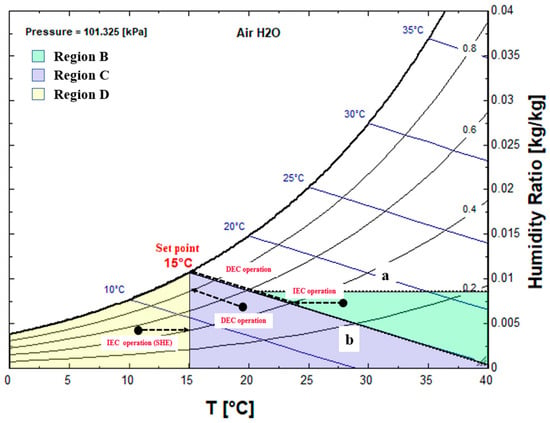
Figure 3.
The operating processes B, C, and D of the LD-IDECOAS.
In the winter, LD and DEC do not work and heat is recovered by IEC and SHE installed on the exhaust side, as depicted in the yellow part of Figure 3. This shows the operation of the neutral deck of the proposed system and denotes as the role of the SHE without using water in the second side of the IEC. At this time, the IEC begins to function as the SHE will recover the sensible heat from the EA side and perform the primary preheating to meet the set point. However, if the target temperature is not reached when only IEC is used, the heating coil located on the exhaust side is used to ensure compliance with the set-point condition.
The above description applies to all operating modes of the LD-IDECOAS which are modulated by the state of the outside air.
2.2. IDECOAS
Figure 4 depicts the IDECOAS proposed in this study. The proposed IDECOAS consists of the IEC, CC, and DEC. The HC and SHE were installed as the exhaust side configuration of the proposed LD-IDEOCAS. In the path of the outside air, the primary channel of the IEC passes first, followed by the CC and DEC. The flow rate of the SA is the same as that of the conventional VAV system, similar to the case of the proposed LD-IDECOAS and it fluctuates according to the heat load of the building space.
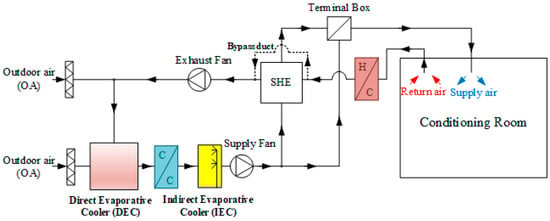
Figure 4.
The schematic of IDECOAS.
In the proposed IDECOAS, similar to the LD-IDECOAS proposed above, the operation is divided into four operation modes. Depending on the outdoor air conditions, the operation mode is selected and the system is operated according to the selected mode, as shown in the psychrometric chart of Figure 5.
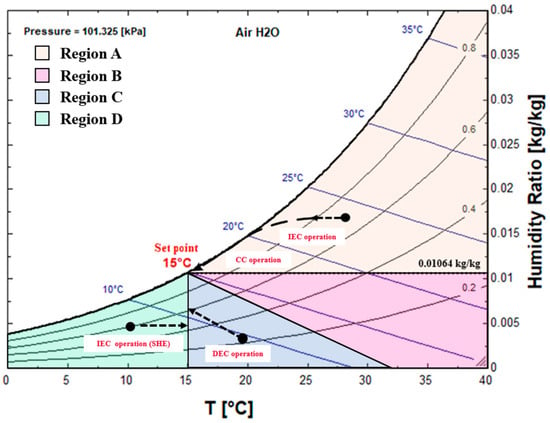
Figure 5.
The operating modes for IDECOAS depicted on a psychrometric chart.
First, mode A is used to represent the cooling season (Figure 5) and the operation of this mode is mainly performed by IEC and CC. The ambient air belonging to region A is higher than the set temperature and the absolute humidity is higher than the set absolute humidity. The air that passes through the secondary side of the IEC is subjected to scavenged air with a relatively lower wet bulb temperature in the outdoor air and the EA. In order to reduce the energy consumption of the CC, IEC simulated it with the highest efficiency setting. The processed air passing through the IEC passes through the CC and the latent heat and the sensible heat loads of the air are treated to maintain the set air condition. This process involves the process of passing through the cold deck.
Regions B and C, which are listed under the outdoor air conditions, describe the intermediate season. At this time, the outside air is higher than the set temperature, the air is sufficiently dry, and the operation of CC is determined according to the degree of humidity of the outside air. If the enthalpy of the outdoor air is higher than the enthalpy of the set point, it is placed in the B region, and the CC works to handle the latent heat load in the processed air. Additionally, DEC then performs a cooling process along the enthalpy line to maintain the set temperature. Conversely, if the enthalpy is lower than the set enthalpy, it enters region C, whereby only the DEC operates and adiabatic cooling occurs.
There are two possible situations when ambient air is in Mode B (Figure 6). If it is located in region B, the IEC will operate first. At this time, there are two cases. In the case of situation a in region B, the set point enthalpy cannot be reached even after IEC is applied, and CC works to handle the latent load in the air. After CC is cooled to the set point enthalpy, the cooling process is executed along the enthalpy line to maintain the set DEC temperature. If the IEC has been sufficiently cooled to reach the enthalpy line of the set point or has cooled more than the set point enthalpy, DEC is immediately used to achieve cooling to the set point temperature.
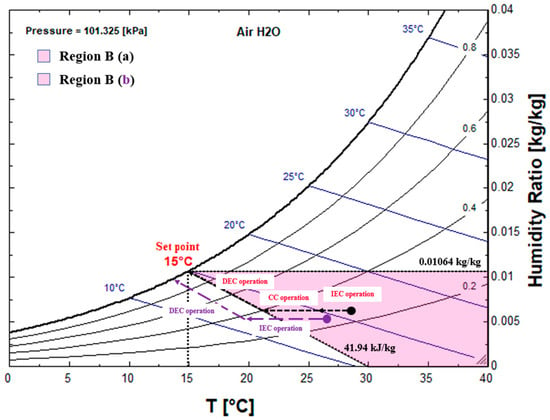
Figure 6.
The two operating mode in IDECOAS region B.
If the enthalpy of the outdoor air is lower than the set enthalpy, as shown in the blue portion of Figure 5, that is, when it matches situation b in region B and enters region C, adiabatic cooling is performed only based on the DEC operation.
The green portion of Figure 5 shows the system’s operation during the winter when the outside air temperature is lower than the set temperature. At this time, heating is required and the CC and DEC responsible for the cooling operation are turned off. The IEC is used like SHE and the air passing through the secondary side preheats the air passing through the primary channel by the wasted heat recovered from the EA stream. Similar to the proposed LD-IDECOAS, in the heating season, the SHE located on the exhaust side recovers heat in the effort to heat the processed air before it sends it to the air-conditioning unit. If the set temperature is not satisfied, even if it passes through the IEC preheating and neutral deck, the HC is turned on to satisfy the set conditions.
2.3. VAV System
In order to compare the energy performance with LD-IDECOAS, a VAV system with a reheating coil (RHC) was used to prevent overcooling problems in the cooling section of the CC (Figure 7). The economizer on the air side was used in this simulation. The cooling process of the air-conditioning space was mainly carried out by CC. On the cooling coil side, a water-cooled chiller was applied and was operated to maintain the supply air temperature (that is, 15 °C saturated). If the temperature of the processed air was lower than the set point temperature after CC, the RHC starts to operate. In the summer, when the undesired overcooling occurs owing to the operation of the cooling coil, the RHC is operated to raise the temperature of the processed air. When it is extremely hot and humid, not only is the required cooling load increased, but the energy consumption is also increased at the heating side, and the energy consumption of the entire system is increased. The supply air flow of the VAV is basically changed according to the heat load of the room and the minimum ventilation requirement is determined according to the information provided in the ASHRAE standard 62.1-2013 [22].

Figure 7.
The schematic of VAV system.
3. Energy Simulation
3.1. Selection of the Region to be Simulated
Because of its vast land area of 9.6 million square kilometers, China has a very complex terrain and a diverse and distinct climate. Owing to the complexity of the terrain, China has created a very diverse and distinct climate. China’s climate classification is largely divided into five major climatic zones for thermal environmental design according to the GB50176-93 “Thermal Design Code for Civil Building standards” [23]. The monthly average temperatures of the hottest month and coldest month in each region were the criteria for dividing the entire country into different regions. As shown in Figure 8, these regions include the severe cold, mild, hot summer, cold winter, hot summer, warm winter regions, and the very cold regions. In this study, the cities were located in six different climatic zones and were selected for simulations of the energy performance of the proposed system in regions with different outdoor conditions, as shown in Figure 8.
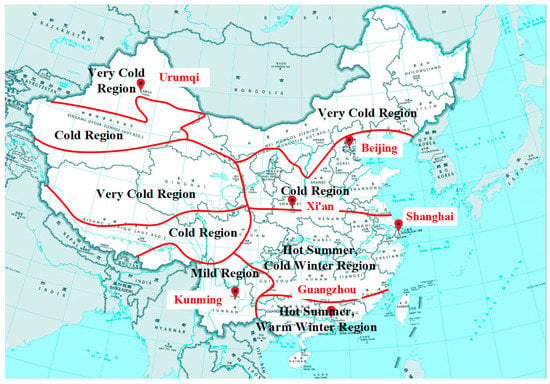
Figure 8.
The climate distribution map of China.
As a representative city for each climate area, there is a significant difference in outdoor conditions, as shown in Figure 9 and Figure 10, which indicate the changes in the annual outdoor conditions of each city. Beijing, Urumqi, Kunming, and Xi’an, all belong to relatively dry climate regions, while Guangzhou and Shanghai are classified as humid regions. In addition, Urumqi has lengthy winter climate features and Guangzhou’s annual temperature difference is very low and it has a very warm climate in winter. The meteorological data of the six selected regions were exported by the TMY2 weather data provided in TRNSYS 17 [24] and the thermal load of buildings, outdoor air (OA) conditions, and return air conditions were applied to the simulation to calculate the air flow in each region.

Figure 9.
The comparison of outdoor temperatures of selected cities.

Figure 10.
The comparison of humidity ratios of selected cities.
3.2. Model Building Information
For this simulation, one office building located in Guangzhou, China was set up as a model building for simulations. This selected building was located on the upper floor and the total area was approximately 300 m2. Table 1 summarizes the various basic conditions for the building model. In the energy simulation program TRNSYS 17, the set indoor conditions and sensible heat load and latent heat loads of the buildings in each selected area are calculated. In the process of the building energy simulations, standardized thermal transmittance was set according to the Chinese national standard GB 50189-2015 [25]. The window-to-wall ratio was also set according to this standard. In all areas it is prescribed that the area of the window should not exceed 0.8 when it is proportional to the wall. In addition, the JG67-2006 standard, “Office Building Design Criteria” in China, also standardizes the standard room temperature and relative humidity of the cooling and heating seasons in various regions [26]. According to JG67-2006, the standard room temperature is 26 °C in the summer and 18 °C in the winter. The relative humidity of the summer should be less than 60% and in winter it should be more than 30%. The thermal transmittance of the exterior walls of the buildings in Beijing, Guangzhou, Urumqi, and Xi’an were 0.50 W/m2 K, 0.80 W/m2 K, 0.43 W/m2 K, and 0.50 W/m2 K, respectively. The thermal transmittance of the outer wall of Kunming was determined to be 0.80 W/m2 K. Similarly, the thermal transmittance of the outer wall in Shanghai was 0.6 W/m2 K. In accordance with the standard ISO 7730, residents of office buildings were assumed to perform light duties, with the sensible heat and latent heat of a 75 W/person considered. The building’s computer type, lighting, and lighting/work schedule, are were set according to the values listed in Table 1.

Table 1.
The physical information of the model buildings studied herein.
3.3. Simulation Overview
In the proposed system, the highest energy conservation benefit comes from the LD system. After an exothermic dehumidification process, an undesired heat transfer to the processed air will occur, thereby raising the temperature of the dehumidifier and making it impossible to maintain its set temperature. Therefore, the regenerated dehumidified solution is cooled by the cooling device and then supplied to the dehumidifier. Herein, it is believed that free cooling on the water side using a CT can save more energy to reduce the energy consumption of the cooling system. The dehumidification solution of the dehumidifier removes the moisture from the incoming air and then becomes a diluted solution. It enters the regenerator, regenerates it, and then makes it into a dehumidifier. In the process of regenerating the solution, a large amount of heat is usually required. In most cases, a gas boiler or an electric water heater is used as the heating device. In recent years, more energy efficient and more environmentally friendly renewable energy system heat sources, such as solar thermal systems, have achieved widespread usage. Since coal resources are high in China, it has been determined that using coal as a district heating source has significant advantages in terms of energy conservation. It is expected that the setting of the cooling unit of the dehumidifying cooling part of the LD system and the heating part of the regeneration heating part have considerable energy potential.
The dehumidification efficiency of the LD system is based on the equilibrium humidity ratio, denoted by the actual removal rate of the moisture to the maximum moisture removal rate. The humidity ratio of the air from the dehumidifier () can be found based on the expression of the dehumidifier’s efficiency (Equation (1)). For this calculation, the dehumidification efficiency (), the humidity ratio of the air entering the dehumidifier (), and the equilibrium humidity ratio of the dehumidifier () must all be known.
The regenerative efficiency is the ratio of the actual evaporation rate to the maximum evaporation rate based on the equilibrium humidity ratio. The humidity ratio of the air from the regenerator () can also be obtained from the efficiency of the regenerator, in accordance to Equation (2). Equations (1) and (2) were verified by various experimental studies [17,18,27,28,29,30]. When calculating the humidity ratio, the regeneration efficiency (), the humidity ratio of the air entering the regenerator (), and the equilibrium humidity ratio of the generator () must all be given.
Equation (3) shows the equilibrium humidity ratio () of the dehumidifier and regenerator mentioned above. The saturated vapor pressure () in this equation was derived from Equation (4), as proposed by Fumo and Goswami [30]. Various parameters applied in Equation (4) are also known in the literature and depend on the dehumidification process and the regeneration process. This is summarized in Table 2 [31].

Table 2.
The physical information of the model buildings studied herein.
In this study, the application of the efficiency equation of the dehumidifier (Equation (5)) was chosen in accordance to the experimental model of Chung and Luo [31], and the efficiency equation of the regenerator (Equation (6)) was modeled by Martin and Goswami [32].
The temperatures of the air passing through the dehumidifier or the regenerator were confirmed using Equation (7), which expresses a temperature difference ratio. In this case, the temperature ratio (), the temperature of the air entering the dehumidifier or the regenerator (), and the temperature of the solution entering the dehumidifier () should be given.
The current literature shows that the temperatures of the dehumidifier and the regenerator are similar [13,33].
In this study, the liquid-to-gas ratio (L/G ratio) was set to values in the range of 0.5 to 1 and the solution concentration at the dehumidifier inlet was set to 40%. The efficiency of the SHE of the LD system is was assumed to be 70% and the solution temperature at the inlet is was assumed to be 30 °C. On the regeneration side, the inlet temperature was set to 55 °C and the liquid-to-gas ratio (L/G ratio) was set to 4.
The processed air passes through the LD system and through the evaporative cooler. Because the dehumidified air passes through the IEC’s primary panel, there is no humidity change and the humidity ratio of the air from the IEC is equal to the humidity ratio of the air passing through the LD system. The air passing through the IEC is cooled and the exit temperature of the IEC can be derived in accordance to Equation (8). In this simulation, the IEC efficiency was set to 80%, while the efficiency of the DEC was set to 95%. Correspondingly, the temperature of the wet bulb from the IEC can be calculated using Equation (9). Equations (8) and (9) were also verified by literature studies [17,18].
All of the processes mentioned above were used in EES for simulation and energy performance analyses [34].
3.4. Simulation Flow Chart
Figure 11 shows the simulation diagram of IDECOAS and Figure 12 shows the simulation process of the proposed system.
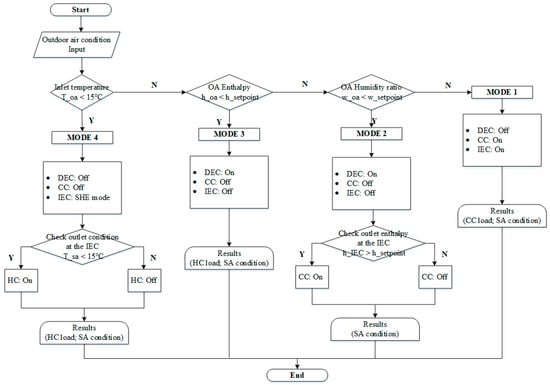
Figure 11.
The flow chart of the IDECOAS simulation.
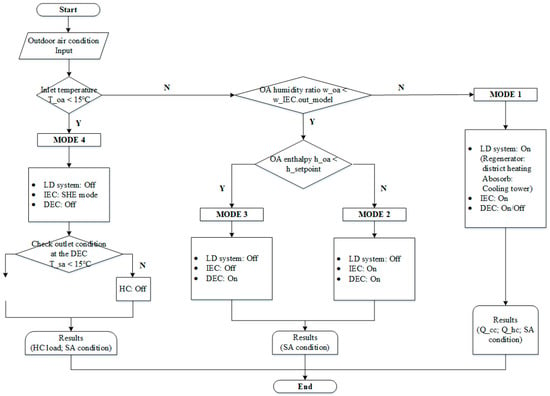
Figure 12.
The flow chart of the LD-IDECOAS simulation process.
4. Simulation Results
4.1. Comparative Analyses of Seasonal Results
The simulation of the proposed system was carried out annually to evaluate how regions with various climatic characteristics were constructed in operational mode, and to compare the energy savings between the systems. Figure 13, Figure 14, Figure 15, Figure 16, Figure 17 and Figure 18 compare the seasonal results of the three systems operating in each city. In order to analyze the results accurately, all simulation results were converted into primary energy according to the first energy conversion standard in China, GB/T2589-2008 [35]. In this standard, the conversion coefficient is 0.1229 kgce/KWh when the electric energy is converted to coal energy. The conversion coefficient is 0.03412 kgce/KWh when the thermal energy of the district heating used in the regeneration side of the LD system is converted to coal energy. When the thermal energy was changed to the appropriate unit, the conversion factor was changed to 0.009485 kgec/KWh. The conversion standard of primary energy, that is, the energy consumption of coal, is shown in Table 3.

Figure 13.
The seasonal energy consumption comparison in Beijing.

Figure 14.
The seasonal energy consumption comparison in Urumqi.

Figure 15.
The seasonal energy consumption comparison in Xi’an.

Figure 16.
The seasonal energy consumption comparison in Kunming.

Figure 17.
The seasonal energy consumption comparison in Guangzhou.
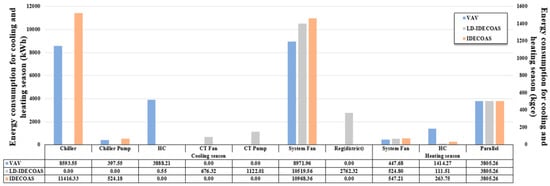
Figure 18.
The seasonal energy consumption comparison in Shanghai.

Table 3.
The coal energy conversion factor.
Figure 13 shows a comparison of energy consumption when three systems are applied in the Beijing region. In the summer, the VAV and IDECOAS systems are both subjected to load handling by the cooling coil, while in Beijing, IDECOAS consumes more energy than the conventional VAV system. The energy change of the cooling coil part in the IDECOAS is mainly due to the pre-cooling effect of the IEC. If the IEC efficiency is high, the cooling coil consumption in the IDECOAS is reduced and if the IEC efficiency is low, the cooling coil is used extensively. In this simulation, the IEC efficiency was set to 80%, but the IEC efficiency did not reach 80% during the operation of the actual system. In the summer in the Beijing region, the cooler consumption is high owing to the slightly hot and humid conditions, and the limited cooling performance of the IEC. However, the proposed system consumed more fan energy owing to the introduction of LD. The energy-saving system, such as the CT and district heating, was applied in the proposed system, and the energy used for the fan part was thus complemented by this. As a result, in the summer in the Beijing region, the proposed system yielded an energy saving of approximately 35.25% compared to the VAV system and can save an additional energy of approximately 20.44% compared to IDECOAS. In the winter, it consumes 38.19% less energy than the conventional VAV system.
As it can be observed from Figure 14, the summer energy consumption in the Urumqi area is much smaller than that for the Beijing area, as mentioned above. This is also due to the special ambient conditions in the Urumqi area. Because the summer in the Urumqi area is shorter than the winter period, the energy consumption is smaller than in other areas. As this is a very dry area, the dehumidification part of the proposed system is considered to be unnecessary. As a result, in the summer, the energy saving of the LD-IDECOAS is 12.96% compared to the energy used by the VAV system and 14.54% compared to the energy used by IDECOAS. It is, thus, not necessary to add the dehumidification part separately and IDECOAS is more profitable. The winter is long in this region, and the temperatures are very low. In the winter, the proposed system saves approximately 91% of the energy consumed by the conventional VAV system.
The seasonal energy consumed in Xi’an, as shown in Figure 15, is similar to that consumed in the Beijing region, and because of the precooling of the IEC part of IDECOAS, the energy consumed in the cooler section is slightly lower than that of the VAV. Here too, the proposed system consumes more energy in the fan section owing to the system configuration, but this can be offset by the thermal energy consumption in the proposed system. In terms of the total energy consumption, the proposed system saves approximately 39.4% of the energy consumed by the VAV system, and approximately 22.96% less energy compared to IDECOAS.
Seasonal energy consumption figures of Kunming are shown in Figure 16. The outside air of the city is said to be warm and comfortable. It is a relatively dry area. The annual temperature variation is not large and the cold and hot weather conditions are not extreme. In the summer, this system consumes approximately 18.81% less energy than the existing VAV system.
As shown in Figure 17, the climate characteristics of the area can be observed in the Guangzhou area, whereby the cooling energy consumption occurs in winter. This area is a hot and humid area and the winter season is absent. Therefore, IDECOAS consumes more cooling energy than VAV owing to the latent and the sensible heat loads of the introduced outdoor air. In this region, the proposed system is absolutely necessary. Owing to the dehumidification effect of LD, the proposed system energy savings are approximately 22% in the summer and 15.73% in the winter. Compared with IDECOAS, the energy consumption was 25.63% less than that consumed by VAV in the summer period.
The Shanghai area has four distinct seasons (Figure 18) and its cities are representative of hot and humid cities similar to the Guangzhou area discussed above. Hot and humid days mainly occur in the summer. Therefore, when compared to the VAV system and IDECOAS, 31% and 34.17% of energy savings were achieved compared to Guangzhou, respectively.
In conclusion, IDECOAS could be more profitable in very dry areas, whereas the proposed system has more energy potential in hot and humid areas. Even in warmer areas like Kunming, the proposed system would be more advantageous in terms of energy when only the summer period is considered.
4.2. Comparison of Annual Energy Consumption
Figure 19 compares the system’s energy consumption for the LD-IDECOAS, VAV, and the IDECOAS systems, when they are applied in the Beijing region throughout the year. In the LD-IDECOAS, it is easy to observe in the figure that CC is not used, and the CT in the LD system is much smaller than the other two systems that use CCs. The system fan consumption owing to a high-pressure drop will be greater than the other two systems. However, this deficiency is considered to be supplemented by the energy saved in the cooler section. As a result, the proposed system saves approximately 36.7% of the system’s operating energy over the VAV system and reduces the energy of the system by approximately 8.55% compared to IDECOAS.
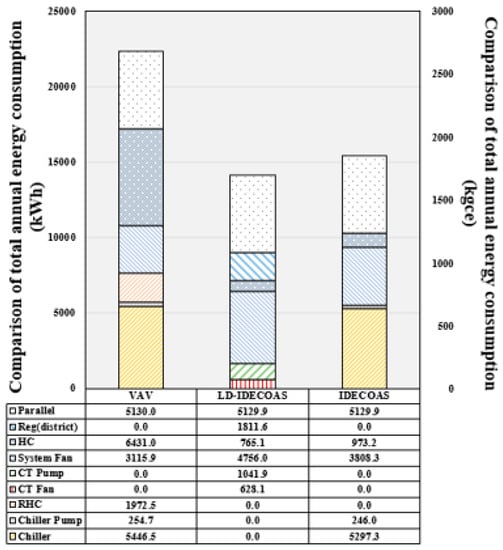
Figure 19.
The total annual energy consumption of each system in the Beijing region.
Figure 20 compares the energy consumption of the three systems operating in the Urumqi region. In Urumqi, it is possible to confirm that LD-IDECOAS is much more energy-efficient than the VAV system even though it has shorter summer and longer winter periods compared to the other regions. It has been confirmed that the CT usage in the LD section is much smaller than the CC application, which is similar to the Beijing region, and it is also related to the use of evaporative coolers. Owing to the shorter summertime, the application time to the air-conditioning system in the summer is shorter and the energy-saving potential of the cooling side is not seen much. Therefore, the analyzed annual energy consumption is similar to IDECOAS. The proposed system used approximately 34.55% less energy than VAV and 0.04% less energy than IDECOAS.
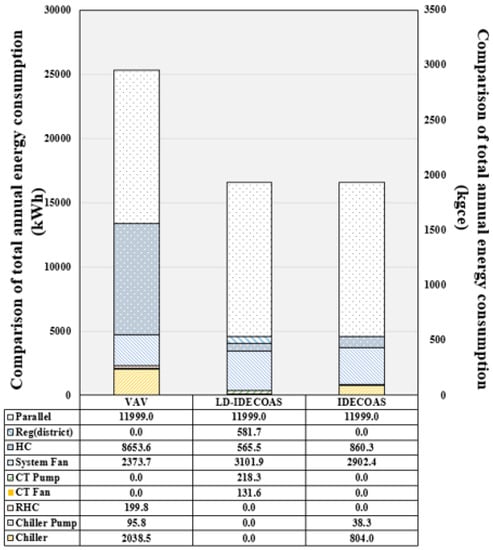
Figure 20.
The total annual energy consumption of each system in the Urumqi region.
Shown in Figure 21 are the simulation results for the Xi’an region. Xi’an is located in the same climate zone as the Beijing region and the energy consumption results are also similar. The LD section and the evaporative cooler were used to reduce the energy consumption by approximately 76.42% compared to the CC part of the VAV system. The penalty associated with the fan cannot be avoided equally, but it seems to be offset by the saved cooling energy. Therefore, the proposed system reduced the energy consumption by approximately 41.78% compared to VAV and saved energy by approximately 15.13% compared to IDECOAS.
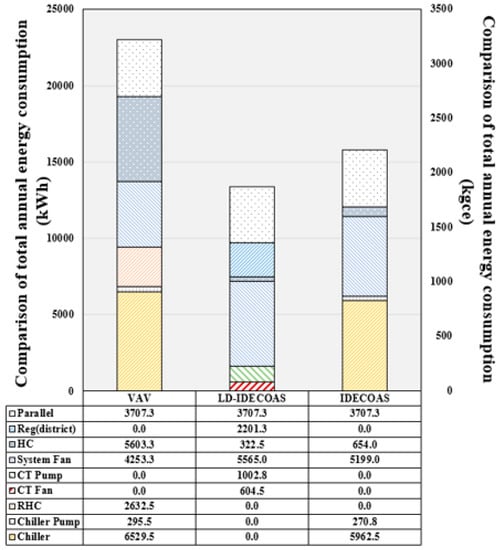
Figure 21.
The total annual energy consumption of each system in the Xi’an region.
Out of the six selected areas, the Kunming area is a warm and very dry region, unlike the other areas. In Kunming, similarly to other dry areas, the potential for energy savings in the cooling area is clearly visible and the fan consumption is high (Figure 22). However, because of the dry ambient air, the requirement of the LD is also small. It has been confirmed that the amount of dehumidification used is much lower than in other areas. Unlike other regions, the energy consumption of LD-IDECOAS is energy efficient as it saves energy compared to VAV but consumes more energy than IDECOAS. This is because it is the smallest of the six regions where the total energy consumption is chosen. The final simulation results in this area show elicited reductions in energy consumption of approximately 26.05% compared to VAV, and approximately 12.05% compared to IDECOAS.
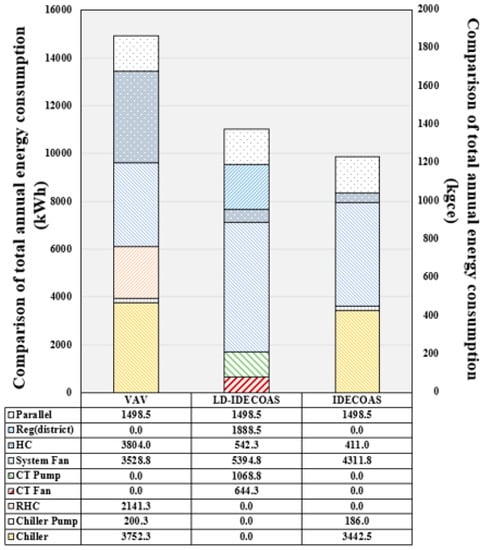
Figure 22.
The total annual energy consumption of each system in the Kunming region.
Shown in Figure 23 is the total annual energy consumption of each system in the Guangzhou area. Guangzhou can yield energy savings in reference to the LD part owing to the hot and humid weather condition throughout the year. Correspondingly, the LD part is used more and the fan usage is also increased. Therefore, although the advantages of the proposed system are better than those of the other systems, the usage of the proposed system is also high. The final annual data analysis shows that the energy saving is approximately 18.91% compared to VAV and that the energy consumption is approximately 15.83% less than IDECOAS.
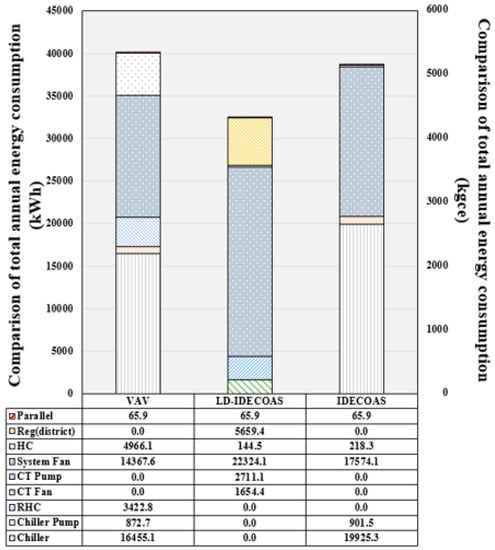
Figure 23.
The total annual energy consumption of each system in the Guangzhou region.
Figure 24 shows the annual energy consumption of each system in Shanghai with hot and humid summer atmospheric conditions. Shanghai was hot and humid in the summer and the use of the LD system was able to save energy. Together with Guangzhou, Shanghai has four distinct seasons during the year, which can be seen to be even more beneficial in terms of their energy-saving capacity. The energy savings are approximately 24.86% compared to VAV, and approximately 24.56% compared to IDECOAS.
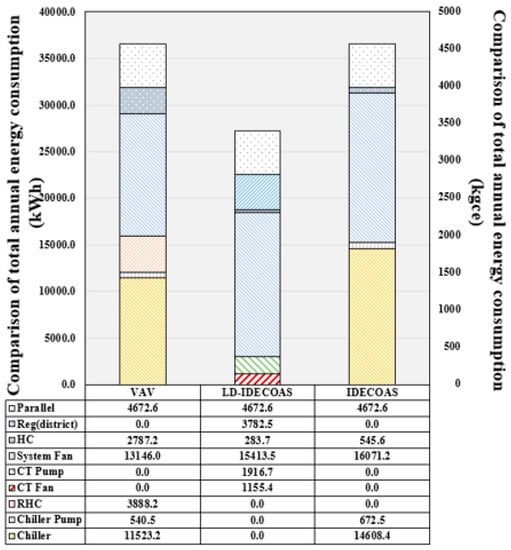
Figure 24.
The total annual energy consumption of each system in the Shanghai region.
Overall, the above denote a section on the comparative analyses of the results of the three systems in each region as the result outcomes of the simulations conducted throughout the period of the year.
5. Conclusions
In this study, the integrated LD system in IDECOAS was proposed and evaluated for applicability based on energy simulations through its application in different climate and outdoor conditions. LD-IDECOAS with district heating has been simulated and the energy consumption results were compared with the conventional IDECOAS and VAV systems. The conditions were set according to the various Chinese standards that were applied at the stage of the simulation. The results of this study are as follows;
- The results of the seasonal analysis show that LD-IDECOAS can save considerable energy when applying LD-IDECOAS in all regions compared with the conventional VAV system.
- In addition, in seasonal results, IDECOAS is better in the Urumqi region, which has a very cold and dry condition, and Kunming region with special ambient conditions, compared to LD-IDECOAS. In hot and humid areas, the application of LD-IDECOAS is much better.
- The annual results show that LD-IDECOAS saved much more energy than the VAV systems in all regions.
- When LD-IDECOAS is compared with IDECOAS in the annual results, the energy consumption results in the dry areas are not much different, but they may vary depending on the area characteristics. The more the drying, the less the dehumidification performance of the LD system is needed, so the application of IDECOAS is more advantageous. In this study, it was found that the application of LD-IDECOAS is more advantageous in hot and humid areas.
Overall, the application of LD-IDECOAS shows better energy-saving potential in most areas, and IDECOAS may be more advantageous in very dry climatic regions, depending on local characteristics. Additionally, in hot and humid areas, using LD-IDECOAS can achieve high energy savings.
Author Contributions
S.L. and J.-W.J. performed the simulation and data analysis and wrote this paper based on the obtained results.
Acknowledgments
This work was supported by the Korean Agency for Infrastructure Technology Advancement (KAIA) grants (18CTAP-C116268-03, and 18CTAP-C141826-01), and the Korea Institute of Energy Technology Evaluation and Planning (KETEP) (No. 20164010200860).
Conflicts of Interest
The authors declare no conflict of interest.
Nomenclature
| desiccant concentration (%) | |
| gas flow rate (kg/s) | |
| liquid flow rate (kg/s) | |
| enthalpy (kJ/kg) | |
| desiccant vapor pressure (kPa) | |
| Temperature (°C) | |
| humidity ratio (kg/kg) | |
| low- wetting characteristics of desiccant solution | |
| high- wetting characteristics of desiccant solution |
Abbreviations
| WBT | wet-bulb temperature (°C) |
| IEC | indirect evaporative cooler |
| DEC | direct evaporative cooler |
| LD | liquid desiccant |
| VAV | variable air volume |
| IDECOAS | indirect and direct evaporative cooler assisted 100% outdoor air system |
| LD-IDECOAS | evaporative cooler assisted 100% outdoor air system integrated with liquid desiccant system |
| OA | outdoor air |
| RA | return air |
| SA | supply air |
| EA | exhaust air |
| SHE | sensible heat exchanger |
| LiBr | lithium bromide |
Greek symbols
| effectiveness (%) |
Subscripts
| cooling coil | |
| cooling tower | |
| equilibrium | |
| heating coil | |
| regeneration part | |
| system | |
| reheating coil |
References
- Kim, M.H.; Choi, A.S.; Jeong, J.W. Energy performance of an evaporative cooler assisted 100% outdoor air system in the heating season operation. Energy Build. 2012, 49, 402–409. [Google Scholar] [CrossRef]
- Kim, M.H.; Kim, J.H.; Kwon, O.H.; Choi, A.S.; Jeong, J.W. Energy conservation potential of an indirect and direct evaporative cooling assisted 100% outdoor air system. Build. Serv. Eng. Res. Technol. 2011, 32, 345–360. [Google Scholar] [CrossRef]
- Kim, M.H.; Jeong, J.W. Cooling performance of a 100% outdoor air system integrated with indirect and direct evaporative coolers. Energy 2013, 52, 245–257. [Google Scholar] [CrossRef]
- Gilani, N.; Poshtiri, A.H. Thermal design of two-stage evaporative cooler based on thermal comfort criterion. Heat Mass Transf. 2017, 53, 1355–1374. [Google Scholar] [CrossRef]
- Chua, K.J.; Xu, J.; Cui, X.; Ng, K.C.; Islam, M.R. Numerical heat and mass transfer analysis of a cross-flow indirect evaporative cooler with plates and flat tubes. Heat Mass Transf. 2016, 52, 1765–1777. [Google Scholar] [CrossRef]
- Chen, Y.; Yin, Y.; Zhang, X. Experimental Analysis of Direct Evaporative Cooling in Special Temperature Range and Extended Application Study. In Proceedings of the 8th International Symposium on Heating, Ventilation and Air Conditioning; Springer: Berlin, Germany, 2013; pp. 399–410. [Google Scholar]
- Lotfizadeh, H.; Layeghi, M. Design and performance analysis of a small solar evaporative cooler. Energy Effic. 2014, 7, 55–64. [Google Scholar] [CrossRef]
- Cannistraro, G.; Cannistraro, M.; Restivo, R. The local media radiant temperature for the calculation of comfort in areas characterized by radiant surfaces. ResearchGate 2015, 33, 115–122. [Google Scholar] [CrossRef]
- Cannistraro, G.; Cannistraro, M.; Restivo, R. Smart control of air climatization system in function on the values of mean local radiant temperature. Smart Sci. 2015, 3, 157–163. [Google Scholar] [CrossRef]
- Jain, S.; Tripathi, S.; Das, R.S. Experimental performance of a liquid desiccant dehumidification system under tropical climates. Energy Convers. Manag. 2011, 52, 2461–2466. [Google Scholar] [CrossRef]
- Goetzler, W.; Zogg, R.; Young, J.; Johnson, C. Energy Saving Potential and RD&D Opportunities for Non-Vapor-Compression HVAC Technologies; Navigant Consulting, Inc., U.S Department of Energy: Burlington, VT, USA, 2014. [Google Scholar]
- Khalid Ahmed, C.S.; Gandhidasan, P.; Al-Farayedhi, A.A. Simulation of a hybrid liquid desiccant based air-conditioning system. Appl. Therm. Eng. 1997, 17, 125–134. [Google Scholar] [CrossRef]
- Katejanekarn, T.; Kumar, S. Performance of a solar-regenerated liquid desiccant ventilation pre-conditioning system. Energy Build. 2008, 40, 1252–1267. [Google Scholar] [CrossRef]
- Gommed, K.; Grossman, G. Experimental investigation of a liquid desiccant system for solar cooling and dehumidification. Sol. Energy 2007, 81, 131–138. [Google Scholar] [CrossRef]
- Odgaard, O. China’s Quest for New District Heating Reforms. 2015. Available online: http://www.thinkchina.ku.dk/documents/2015-12-01ThinkChina_PolicyBrief_DH_and_CHP_in_China.pdf (accessed on 1 December 2017).
- Cannistraro, G.; Cannistraro, M.; Cannistraro, A.; Galvagno, A.; Trovato, G. Evaluation on the convenience of a citizen service district heating for residential use. A new scenario introduced by high efficiency energy systems. Heat Technol. 2015, 33, 167–172. [Google Scholar] [CrossRef]
- Kim, M.H.; Park, J.S.; Jeong, J.W. Energy saving potential of liquid desiccant in evaporative-cooling-assisted 100% outdoor air system. Energy 2013, 59, 726–736. [Google Scholar] [CrossRef]
- Kim, M.H.; Park, J.Y.; Sung, M.K.; Choi, A.S.; Jeong, J.W. Annual operating energy savings of liquid desiccant and evaporative-cooling-assisted 100% outdoor air system. Energy Build. 2014, 76, 538–550. [Google Scholar] [CrossRef]
- Shin, J.H.; Park, J.Y.; Jo, M.K.; Choi, A.S.; Jeong, J.W. Impact of heat pump-driven liquid desiccant dehumidification on the energy performance of an evaporative cooling-assisted air conditioning system. Energies 2018, 11, 345. [Google Scholar] [CrossRef]
- Park, J.Y.; Jeong, J.W. Operating energy savings of a liquid desiccant and evaporative cooling-assisted air handling system in marine applications. Energies 2017, 10, 487. [Google Scholar] [CrossRef]
- Duan, Z.; Zhao, X.; Zhan, C.; Dong, X.; Chen, H. Energy saving potential of a counter-flow regenerative evaporative cooler for various climates of China: Experiment-based evaluation. Energy Build. 2017, 148, 199–210. [Google Scholar] [CrossRef]
- ASHRAE Handbook; American Society of Heating, Refrigerating and Air-Conditioning Engineers, Inc.: Atlanta, GA, USA, 2015.
- Department of Construction of the PRC. Thermal Design Code for Civil Building-GB 50176-1993; China Plan Press: Beijing, China, 1993.
- Klein, S.A.; Beckman, W.A.; Mitchell, J.W.; Duffie, J.A. TRNSYS 17—A Transient System Simulation Program; User Manual; Solar Energy Laboratory, University of Wisconsin-Madison: Madison, WI, USA, 2009. [Google Scholar]
- GB 50189-2015, Design Standard for Energy Efficiency of Public Buildings; Ministry of Housing and Urban-Rural Development of China: Beijing, China, 2015.
- Design Code for Office Building, JGJ67-2006; Ministry of Construction of the People’s Republic of China Zhejiang: Hangzhou, China, 2006.
- Kim, M.H.; Ham, S.W.; Park, J.S.; Jeong, J.W. Impact of integrated hot water cooling and desiccant-assisted evaporative cooling systems on energy savings in a data center. Energy 2014, 78, 384–396. [Google Scholar] [CrossRef]
- Kim, M.H.; Park, J.Y.; Ham, S.W.; Jeong, J.W. Energy conservation benefit of water-side free cooling in a liquid desiccant and evaporative cooling-assisted 100% outdoor air system. Energy Build. 2015, 104, 302–315. [Google Scholar] [CrossRef]
- Ham, S.W.; Lee, S.J.; Jeong, J.W. Operating energy savings in a liquid desiccant and dew point evaporative cooling-assisted 100% outdoor air system. Energy Build. 2016, 78, 535–552. [Google Scholar] [CrossRef]
- Fumo, N.; Goswami, D.Y. Study of an aqueous lithium chloride desiccant system: Air dehumidification and desiccant regeneration. Sol. Energy 2002, 72, 351–361. [Google Scholar] [CrossRef]
- Chung, T.W.; Luo, C.M. Vapor pressure of the aqueous desiccants. J. Chem. Eng. Data 1999, 44, 1024–1027. [Google Scholar] [CrossRef]
- Martin, V.; Goswami, D.Y. Effectiveness of heat and mass transfer processes in a packed bed liquid desiccant dehumidifier/regenerator. HVAC R Res. 2000, 6, 21–39. [Google Scholar] [CrossRef]
- Katejanekarn, T.; Chirarattananon, S.; Kumar, S. An experimental study of a solar-regenerated liquid desiccant ventilation pre-conditioning system. Sol. Energy 2009, 83, 920–933. [Google Scholar] [CrossRef]
- Klein, S.A.; Alvarado, F.L. EES-Engineering Equation Solver for Microsoft Windows Operating Systems, F-Chart Software. 2008. Available online: http://www.fchart.com/ees/ (accessed on 26 October 2017).
- GB/T 2589-2008. General Principles for Calculation of the Comprehensive Energy Consumption. 2008. Available online: https://infostore.saiglobal.com/en-au/standards/gb-t-2589-2008-1082209/ (accessed on 3 February 2018).
© 2018 by the authors. Licensee MDPI, Basel, Switzerland. This article is an open access article distributed under the terms and conditions of the Creative Commons Attribution (CC BY) license (http://creativecommons.org/licenses/by/4.0/).